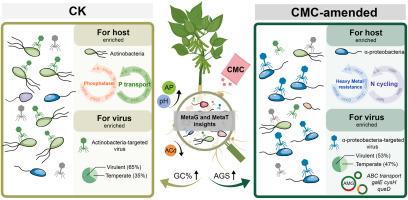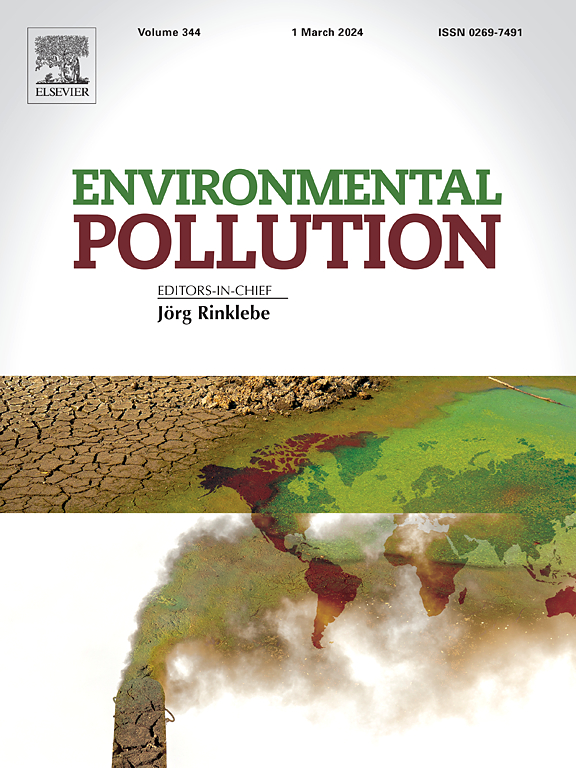Uncovering soil amendment-induced genomic and functional divergence in soybean rhizosphere microbiomes during cadmium-contaminated soil remediation: Novel insights from field multi-omics
IF 7.6
2区 环境科学与生态学
Q1 ENVIRONMENTAL SCIENCES
引用次数: 0
Abstract
Soil amendments exhibit great potential in reducing cadmium (Cd) bioavailability and its accumulation in crop grains, but their practical implications on microbial characteristics (genomic traits and ecological functions) remain unclear. The objective of this study was to combine metagenomics and metatranscriptomics to track the dynamics of bacterial and viral communities in the soybean rhizosphere during the remediation of Cd-contaminated soil using a commercial Mg-Ca-Si conditioner (CMC), applied at low and high (975 kg ha−1 and 1950 kg ha−1) rates under field conditions. Application of CMC increased the average size and decreased the guanine-cytosine (GC) content of microbial genomes, which were strongly shaped by soil pH and available Cd (ACd). Gene and transcript abundances analysis indicated that CMC promoted the enrichment of Alphaproteobacterial metagenome-assembled genomes (MAGs) carrying czcC gene encoding Cd efflux and dsbB gene encoding disulfide bond oxidoreductase. These genes are closely related to Cd resistance and exhibited notable (p < 0.05) increased expression in CMC-treated soils. Additionally, low and high CMC addition significantly increased viral alpha diversity by 5.7% and 9.6%, and viral activity by 3.3% and 7.8%, respectively, in comparison to the control. Temperate viruses were predicted as the major group (64%) and actively linked to the dominant host, and CMC amendment increased host metabolism and adaptability by enhancing (p < 0.05) the abundance and transcriptional activity of virus-encoded auxiliary metabolic genes (AMGs) involved in heavy metal resistance (ABC transport), sulfur cycling (cysH), and host metabolism (galE and queD) through “piggyback-the-winner” strategy. Structural equation modeling further revealed that CMC application influences Cd accumulation in soybean grains through its direct and indirect effects on soil properties and rhizosphere microbiomes, and highlighted the potential role of rhizosphere viruses in agricultural soil remediation.


求助全文
约1分钟内获得全文
求助全文
来源期刊

Environmental Pollution
环境科学-环境科学
CiteScore
16.00
自引率
6.70%
发文量
2082
审稿时长
2.9 months
期刊介绍:
Environmental Pollution is an international peer-reviewed journal that publishes high-quality research papers and review articles covering all aspects of environmental pollution and its impacts on ecosystems and human health.
Subject areas include, but are not limited to:
• Sources and occurrences of pollutants that are clearly defined and measured in environmental compartments, food and food-related items, and human bodies;
• Interlinks between contaminant exposure and biological, ecological, and human health effects, including those of climate change;
• Contaminants of emerging concerns (including but not limited to antibiotic resistant microorganisms or genes, microplastics/nanoplastics, electronic wastes, light, and noise) and/or their biological, ecological, or human health effects;
• Laboratory and field studies on the remediation/mitigation of environmental pollution via new techniques and with clear links to biological, ecological, or human health effects;
• Modeling of pollution processes, patterns, or trends that is of clear environmental and/or human health interest;
• New techniques that measure and examine environmental occurrences, transport, behavior, and effects of pollutants within the environment or the laboratory, provided that they can be clearly used to address problems within regional or global environmental compartments.
 求助内容:
求助内容: 应助结果提醒方式:
应助结果提醒方式:


